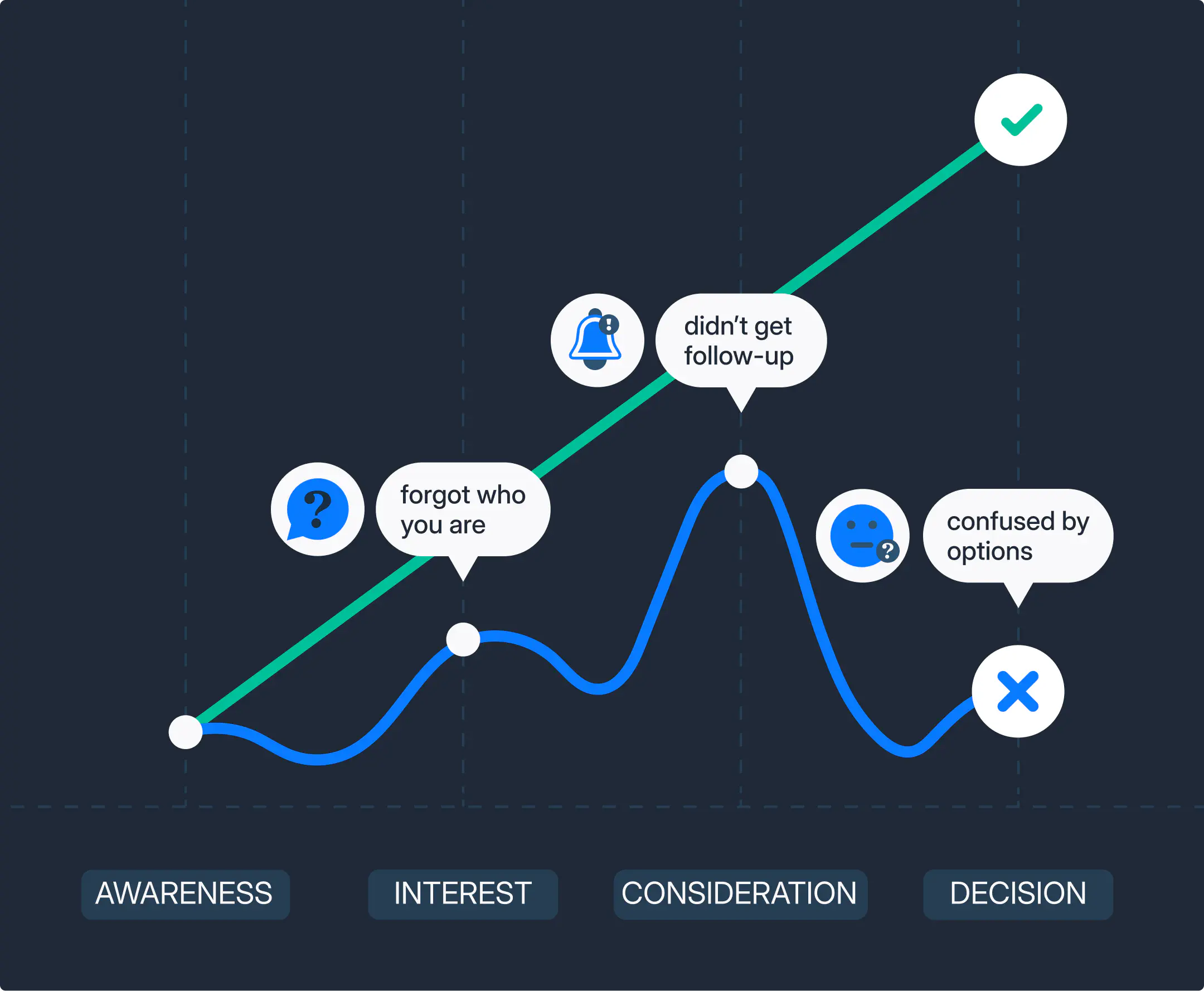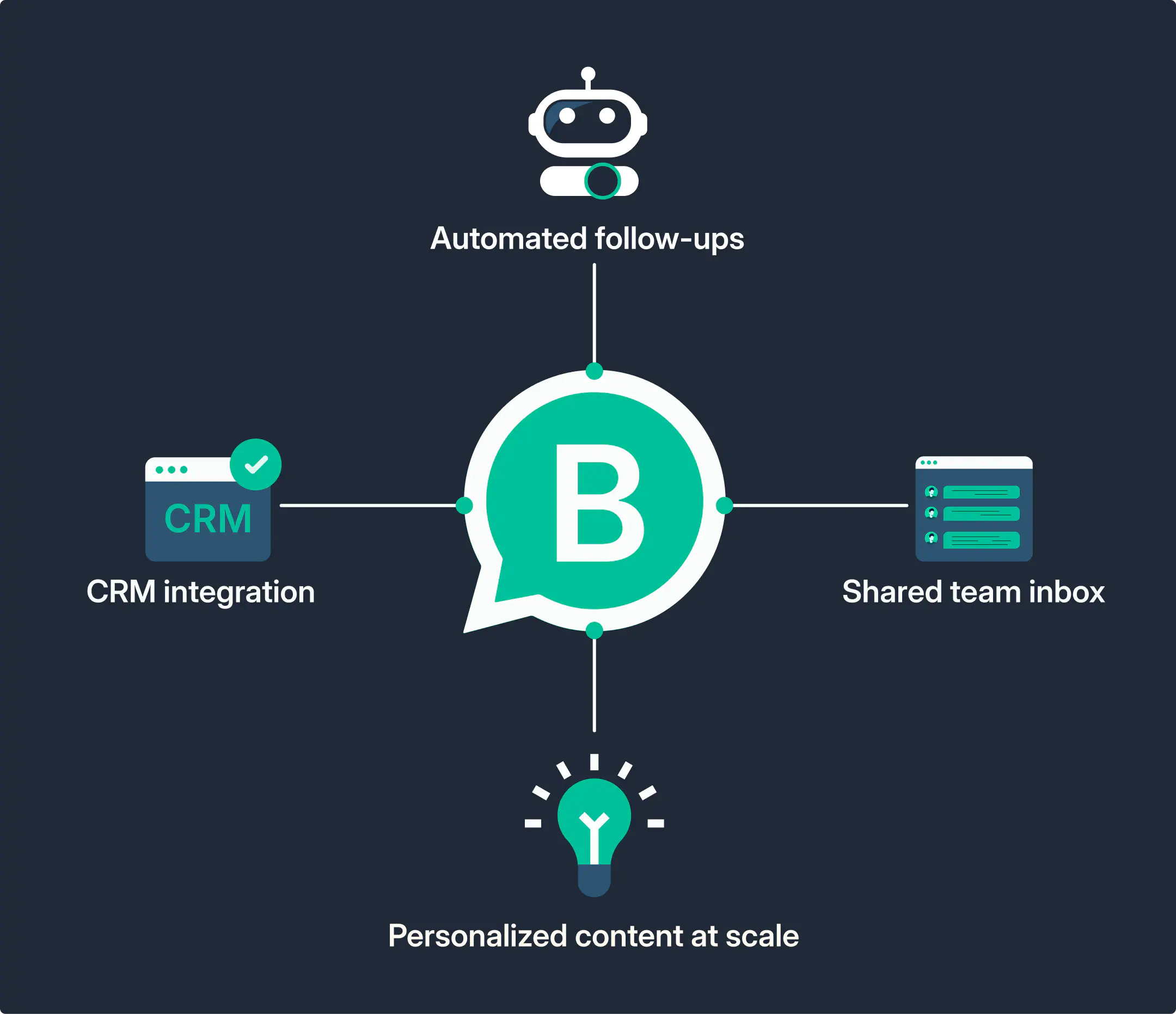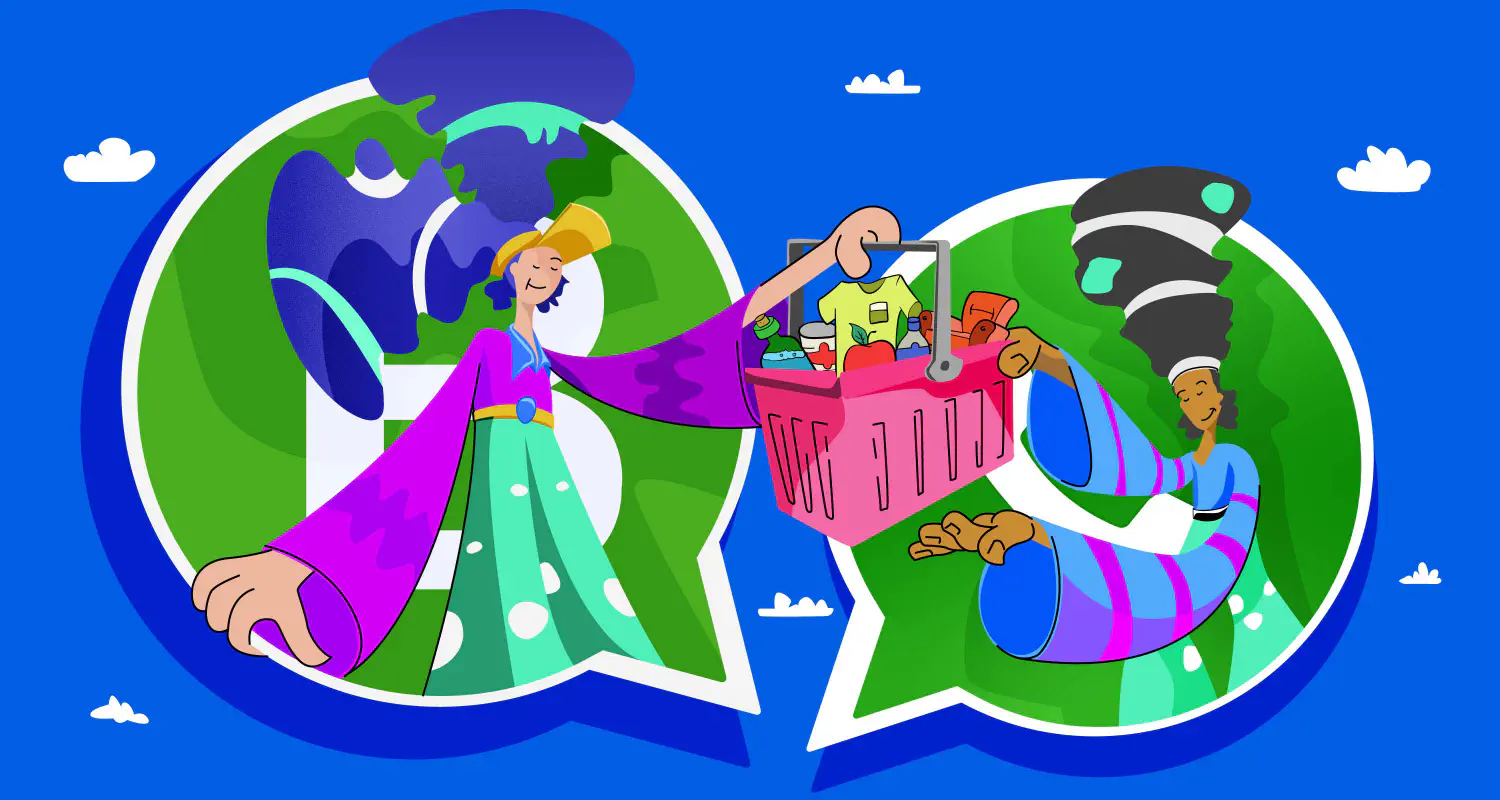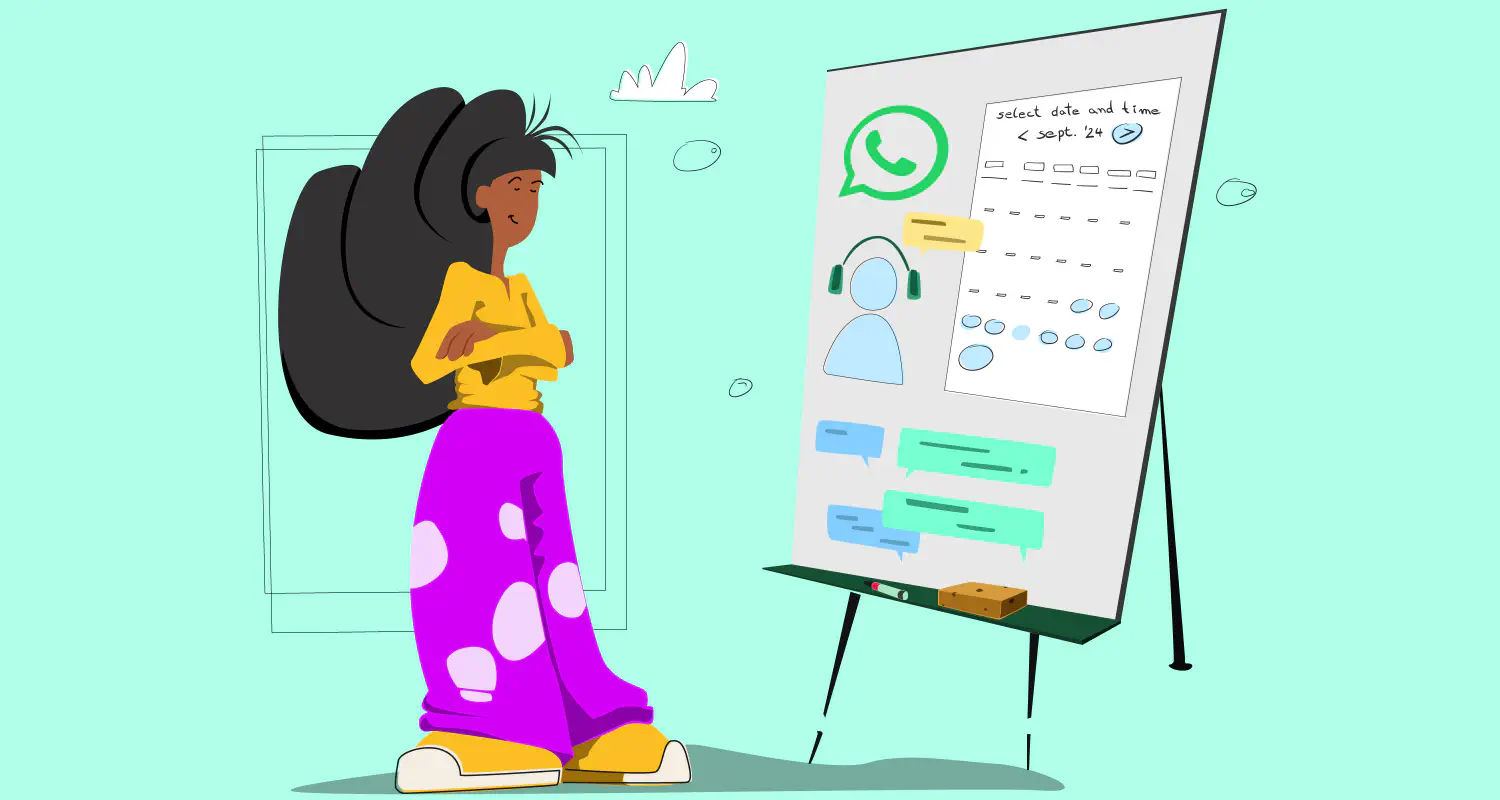How to Nurture Leads on WhatsApp [Proven Strategy for 2025]
![How to Nurture Leads on WhatsApp [Proven Strategy for 2025]](https://learn.rasayel.io/en/blog/whatsapp-lead-nurturing/cover_hu15784667665195158061.webp)
Lead nurturing is how you turn interested customers into buyers, basically, how you build a relationship between your brand and customers. It includes following up regularly, sending personalized messages, providing educational content, and much more.
Nurturing leads on WhatsApp means:
- Using automated follow-ups
- Having your customer data and conversations in one place
- Assigning leads to sales reps automatically based on triggers
But what does a B2B lead nurturing strategy look like on WhatsApp? Can you build it over the WhatsApp Business App, or do you need the full Business Platform?
In this guide, we’ll show you how to build a WhatsApp-based lead nurturing process and which Business version of it you need to use.
Why is lead nurturing important?

Lead nurturing is important because it:
- Helps you build strong relationships with customers that can later turn into sales
- Builds trust with qualified leads who are close to buying
- Educates customers about your product before they go on a sales call
- Shortens the sales cycle because only high-intent leads follow through
- Helps you identify buyer intent by tracking engagement signals
But lead nurturing isn’t as easy as it sounds. Most teams struggle to do it well, mainly because they’re using outdated tools that make it challenging to build a relationship with customers, like emails and cold calls.
And CRMs are another issue. They help you organize your funnel, sure. But do they show you the actual conversations that took place? Can you use them to know who to hold accountable when a lead drops? The answer is probably no, and that’s yet another issue that WhatsApp solves.
Why use WhatsApp to nurture leads

You should use WhatsApp for lead nurturing because it has high open and engagement rates, encourages personalized communication, and your customers are already using it.
Still, why is WhatsApp better than other lead-nurturing channels?
- It’s personal: People treat WhatsApp like a trusted space. Your messages feel more human and get more attention.
- It’s immediate: Customers see messages and respond quickly, keeping the momentum alive.
- It’s scalable: WhatsApp provides automation and AI for medium-to-large businesses, helping them nurture thousands of leads without losing the personal touch.
- It’s already in use: Decision-makers in many regions (MENA, LATAM, India) are already using WhatsApp daily for both work and life.
- It’s trackable: You can measure replies, engagement, and handoffs in real time.
Emails often go into spam folders or get ignored, and phone calls get declined more often than not. People don’t open their emails or respond to stranger phone calls at any time of the day, but they do open WhatsApp.
They open it to reply to friends and family, and when they see your message there every time they open it, they’ll be less likely to ignore it.
Next, let’s show you what the lead-nurturing process looks like on WhatsApp.
How to create a WhatsApp lead nurturing strategy
Here’s how to build a solid lead nurturing process that actually works on WhatsApp.
1. Understand your audience’s needs
To build a nurturing strategy, you first need to study your target audience. You need to know their goals and pain points and understand their behavior.
Start by analyzing:
- Sales call notes – What questions do leads ask before they convert?
- Demo behavior – Where do they drop off or get excited?
- Page visits and click paths – What content are they engaging with?
- WhatsApp conversations – What do leads say when they’re unsure vs. when they’re ready?
- CRM data and past deals – What patterns show up across high-converting leads?
This data helps you understand your leads’ context. The better you understand it, the better you can time your follow-ups, personalize your messages, and deliver the kind of value that keeps them engaged.
Context also helps you segment your customers and shape the rest of your nurturing process. Once you understand their motivations, blockers, and signals of intent, you can group them based on real engagement instead of just the deal stage.
2. Segment your leads
Segmentation is the process of dividing your leads into groups based on their interests and behavior. It helps you customize your follow-ups based on how ready each lead is to buy. If you don’t segment, you’ll send generic messages that might not be relevant to all customers.
Here are three high-impact ways to segment leads in a WhatsApp nurturing workflow:
- By buyer stage:
- A cold lead who just downloaded a guide or filled out a form is likely still exploring. They need educational content, product context, and proof that your solution is even worth considering.
- A warm lead who booked a demo or asked for pricing is closer to a decision. They need specific answers, competitive advantages, and reassurance that your product is the right choice.
- By firmographics:
- A small business may be looking for flexibility, affordability, and quick results.
- A large enterprise might prioritize integrations, scalability, or compliance.
- An e-commerce company likely needs different messaging than a SaaS platform or logistics provider.
- By specific needs or urgency:
- A lead on a budget needs to understand ROI, not just features.
- A lead with an urgent problem wants to know how fast you can help them.
- A technical buyer may care about product architecture or integrations, while a business user just wants the outcomes.
Once you’ve identified your segments, you can use Tags in WhatsApp Business to label and group leads accordingly. This makes it easy to personalize your nurturing flow and automate follow-ups based on each segment.
3. Address customer pains in nurturing content
Addressing customer pains means delivering content that speaks directly to their challenges, goals, and level of readiness.
Generic follow-ups won’t work here. To nurture leads correctly, each message needs to match the segment’s specific needs and buyer stage. That’s what keeps leads engaged and moving forward.
Here’s how to do that for leads at different stages:
- Early-stage cold leads: Focus on short tips, helpful insights, or pain-point-driven content that builds awareness and positions your brand as a helpful guide.
- Mid-funnel leads: Share customer stories, comparison charts, or FAQs that address common objections and show how you stack up against alternatives.
- Hot leads: Go deeper with case studies, ROI examples, or feature walk-throughs to build confidence and prepare them for a sales conversation.
When you use WhatsApp for nurturing, you can share this kind of content in conversational formats: short voice notes, quick PDFs, carousel images, or even automated flows that respond based on replies.
4. Send targeted nurturing messages
Targeted nurturing means sending the right message to the right lead at the right time. It’s how you move from a “blast” approach to a thoughtful, personalized experience that builds real momentum.
Instead of sending the same generic follow-up to everyone, you customize your outreach based on:
- Their buyer stage (awareness, consideration, decision)
- Their industry or company size
- The specific problem they’re trying to solve
For example, a cold lead in retail might get a short tip on solving a common pain point in their industry. Meanwhile, a warm lead from a SaaS company might receive a customer story that mirrors their use case
When leads feel like you’re speaking directly to them, they’re more likely to engage, reply, and trust you.
And with WhatsApp, this kind of targeting is easier than ever. You can use:
- Tags to group leads by segment
- Quick replies to personalize at scale
- Automated WhatsApp workflows that trigger based on previous responses
5. Track nurturing campaign results
Tracking nurturing campaign results means measuring how well your messages are re-engaging leads and moving them closer to a sale. It’s how you know whether your strategy is working or if your leads are just getting messages and ignoring them.
To measure the success of a lead nurturing campaign, you need to set clear, outcome-focused goals. Ask yourself the following questions:
- How many cold leads become warm again?
- How many leads turn into qualified opportunities or customers?
- Are your messages even being seen?
WhatsApp Business provides basic but useful stats like: messages sent, messages delivered, and messages read.
You can also track:
- Response rate per segment
- Engagement per message type (voice notes vs. PDFs, etc.)
- Drop-off points in longer nurturing sequences
If you’re finding that leads are going cold even after multiple touchpoints, it’s a sign to revisit your content, timing, or targeting.
Lead nurturing tips and tricks
- Use automation and AI to stay consistent: Set up WhatsApp auto-replies, reminder flows, or even AI-driven lead qualification to scale while staying consistent with communication style.
- Keep your contact list clean and organized: Regularly remove inactive leads, update tags, and review engagement. A chaotic list might affect performance.
- Repurpose marketing content for WhatsApp: Break down blog posts into tips, turn case studies into quick messages, and adapt visuals for mobile-first sharing.
- Set up lead scoring to prioritize follow-ups: Track replies, clicks, and behaviors to know who’s warming up and when to bring in a human rep.
- Align sales and marketing on messaging: Make sure your nurturing content reflects the same promises and positioning your reps are using in conversations.
- Test, learn, and iterate: Try different formats, timing, and tones. Small changes can unlock big improvements in engagement.
How WhatsApp Business Platform improves lead nurturing

Nurturing leads on the WhatsApp Business app means manually following up, trying to remember where each lead left off, and switching between apps to find the info you need.
It works at first, but then it doesn’t. When you start to scale, managing your sales funnel stages on WhatsApp becomes messy.
The WhatsApp Business Platform is the solution to turn to here. Here’s how a lead nurturing process can look on the WhatsApp Business Platform:
- CRM integration: When WhatsApp connects to your CRM, you can see a lead’s info all in one place. That means you can send messages that actually make sense for where they are, instead of guessing.
- Automation: You can set up flows that automatically send the right message at the right time, like a quick welcome or a reminder. It keeps leads warm without you needing to be online 24/7.
- Lead assignment: Once a lead shows interest, the platform sends them to the right person on your team, based on location, product interest, or anything else. You can set up an automation flow to notify each agent when they get assigned a lead.
- Shared inbox: Your whole team can see who said what, and when from a centralized view. That makes it easy to jump in, follow up, or hand off a lead without losing context.
Lead nurturing examples on the WhatsApp Business Platform
Here are some examples of how to nurture leads on WhatsApp Business Platform.
Triggered follow-up flow after a lead downloads a guide
A cold lead downloads a pricing guide. One minute later, they receive an automated WhatsApp message:
“Hi Ahmed 👋 I saw you downloaded our pricing guide. If you’re comparing options, I can help answer any questions. Want a quick breakdown of the differences?”
This format works because of the following:
- Immediate follow-up to keep the lead warm
- Friendly tone that doesn’t feel automated
- Opened the door to conversation without being pushy
On the WhatsApp Business Platform, you can use the following features:
- Automation for instant response
- Quick replies to guide the next step
- CRM integration to personalize based on the lead’s download
Post-demo nurturing series
After a product demo, the lead receives a 3-part message sequence over 5 days:
Day 1: “Thanks for joining the demo! Here’s a short case study from a team just like yours.”
Day 3: “Still thinking it over? Here’s a quick summary of our pricing plans.”
Day 5: “Want help choosing the right plan? I can walk you through it.”
This lead nurturing sequence on WhatsApp works because of:
- Reasonable timing between messages
- Relevant content (case study, pricing) at the right time
WhatsApp Business Platform features can also help you with this sequence:
- Scheduled messages through automation
- CRM tags to track the stage and trigger the next message
Reactivation sequence for a cold lead
A lead hasn’t replied in 3 weeks. The system sends a message:
“Hey Lina, we haven’t chatted in a while. Totally fine if the timing’s off. Just let me know if you’d like to revisit things later on.”
Two days later, the lead replies:
“Actually yes, can we talk next week?”
This lead nurturing method works because of the following:
- Low-pressure tone made it easy to re-engage
- Timing felt intentional, not random
- Gave the lead a chance to opt back in without guilt
Again, you can use WhatsApp Business Platform here by deploying these features:
- Automation trigger based on inactivity
- Lead assignment once the lead re-engaged
- Shared inbox to provide conversation history to the sales rep who picked it up
Conclusion
Lead nurturing is important to get right because it builds trust, keeps your brand top of mind, and moves leads closer to a buying decision.
However, a common mistake businesses make is using the wrong channel for it. They rely on email alone and don’t consider faster, more personal channels like WhatsApp.
Using WhatsApp Business for lead nurturing can help you engage leads in real-time and build more personal relationships.
And when you use the advanced WhatsApp Business Platform instead of just the free app, you unlock automation, CRM integration, and shared team visibility that helps you scale.
If you’re tired of leads going cold and follow-ups getting buried in inboxes, it’s time to try something built for your needs.
Frequently asked questions
Yes, you can create a lead nurturing sequence on WhatsApp using the WhatsApp Business Platform. You can:
- Set up automated message sequences
- Schedule follow-ups
- Personalize messages using CRM data
- Use interactive elements in messages like buttons
- Track replies and engagement in real-time
To plan WhatsApp nurturing campaigns, you should:
- Study and segment your target audience
- Create customized content for each segment
- Set up automation flows for follow-ups, reminders, etc
- Identify KPIs for tracking results
The tools you need for your WhatsApp lead nurturing strategies are:
- WhatsApp Business Platform for automation, integrations, and team collaboration
- Automation tools for building workflows with triggers
- CRM platform for storing and sharing lead data
- Shared team inbox to bring all these tools together

Miodrag is a seasoned WhatsApp marketing expert with over 15 years of experience in B2B sales and communication. Specializing in the use of WhatsApp Business API, he helps businesses use WhatsApp’s marketing features to grow their sales and improve customer engagement. As one of the early adopters of WhatsApp Business, Miodrag has a deep understanding of its tools and strategies, making him a trusted authority in the field. His insights have helped many businesses with their communication strategies to achieve measurable results.



